Comprehensive Report: South Africa's Economic Analysis and Outlook
VerifiedAdded on 2023/06/10
|10
|1883
|165
Report
AI Summary
This report provides a comprehensive analysis of the South African economy, examining key economic indicators and trends. It begins by assessing the country's real GDP growth rate, which averaged 3.27% annually from the onset of democratic rule through 2012, and details the fluctuations in South Africa's national debt as a percentage of GDP. The report compares South Africa's debt to global standards and other African nations. It further explores gross fixed capital formation, government spending, and revenue, offering insights into the impact of public debt and the potential for economic crisis. The analysis includes graphical representations of debt trends and capital formation. The report concludes with potential solutions for mitigating debt and fostering economic development, such as government transparency, investing in local currency debt markets, and tax collection.

An Analysis of South Africa Economy 1
AN ANALYSIS OF SOUTH AFRICA ECONOMY
Name
University
Unit
Unit Code
City/State
Date
AN ANALYSIS OF SOUTH AFRICA ECONOMY
Name
University
Unit
Unit Code
City/State
Date
Paraphrase This Document
Need a fresh take? Get an instant paraphrase of this document with our AI Paraphraser
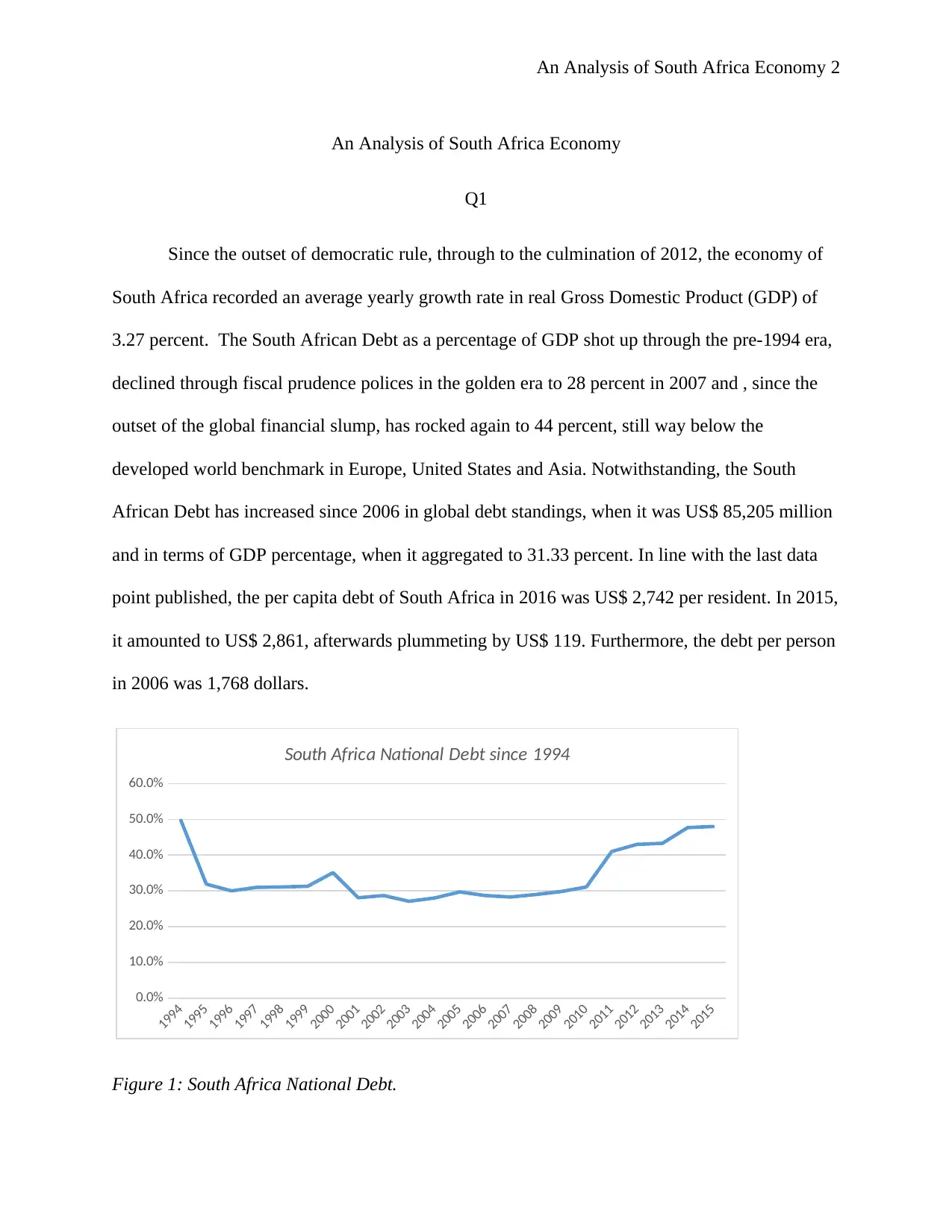
An Analysis of South Africa Economy 2
An Analysis of South Africa Economy
Q1
Since the outset of democratic rule, through to the culmination of 2012, the economy of
South Africa recorded an average yearly growth rate in real Gross Domestic Product (GDP) of
3.27 percent. The South African Debt as a percentage of GDP shot up through the pre-1994 era,
declined through fiscal prudence polices in the golden era to 28 percent in 2007 and , since the
outset of the global financial slump, has rocked again to 44 percent, still way below the
developed world benchmark in Europe, United States and Asia. Notwithstanding, the South
African Debt has increased since 2006 in global debt standings, when it was US$ 85,205 million
and in terms of GDP percentage, when it aggregated to 31.33 percent. In line with the last data
point published, the per capita debt of South Africa in 2016 was US$ 2,742 per resident. In 2015,
it amounted to US$ 2,861, afterwards plummeting by US$ 119. Furthermore, the debt per person
in 2006 was 1,768 dollars.
1994
1995
1996
1997
1998
1999
2000
2001
2002
2003
2004
2005
2006
2007
2008
2009
2010
2011
2012
2013
2014
2015
0.0%
10.0%
20.0%
30.0%
40.0%
50.0%
60.0%
South Africa National Debt since 1994
Figure 1: South Africa National Debt.
An Analysis of South Africa Economy
Q1
Since the outset of democratic rule, through to the culmination of 2012, the economy of
South Africa recorded an average yearly growth rate in real Gross Domestic Product (GDP) of
3.27 percent. The South African Debt as a percentage of GDP shot up through the pre-1994 era,
declined through fiscal prudence polices in the golden era to 28 percent in 2007 and , since the
outset of the global financial slump, has rocked again to 44 percent, still way below the
developed world benchmark in Europe, United States and Asia. Notwithstanding, the South
African Debt has increased since 2006 in global debt standings, when it was US$ 85,205 million
and in terms of GDP percentage, when it aggregated to 31.33 percent. In line with the last data
point published, the per capita debt of South Africa in 2016 was US$ 2,742 per resident. In 2015,
it amounted to US$ 2,861, afterwards plummeting by US$ 119. Furthermore, the debt per person
in 2006 was 1,768 dollars.
1994
1995
1996
1997
1998
1999
2000
2001
2002
2003
2004
2005
2006
2007
2008
2009
2010
2011
2012
2013
2014
2015
0.0%
10.0%
20.0%
30.0%
40.0%
50.0%
60.0%
South Africa National Debt since 1994
Figure 1: South Africa National Debt.
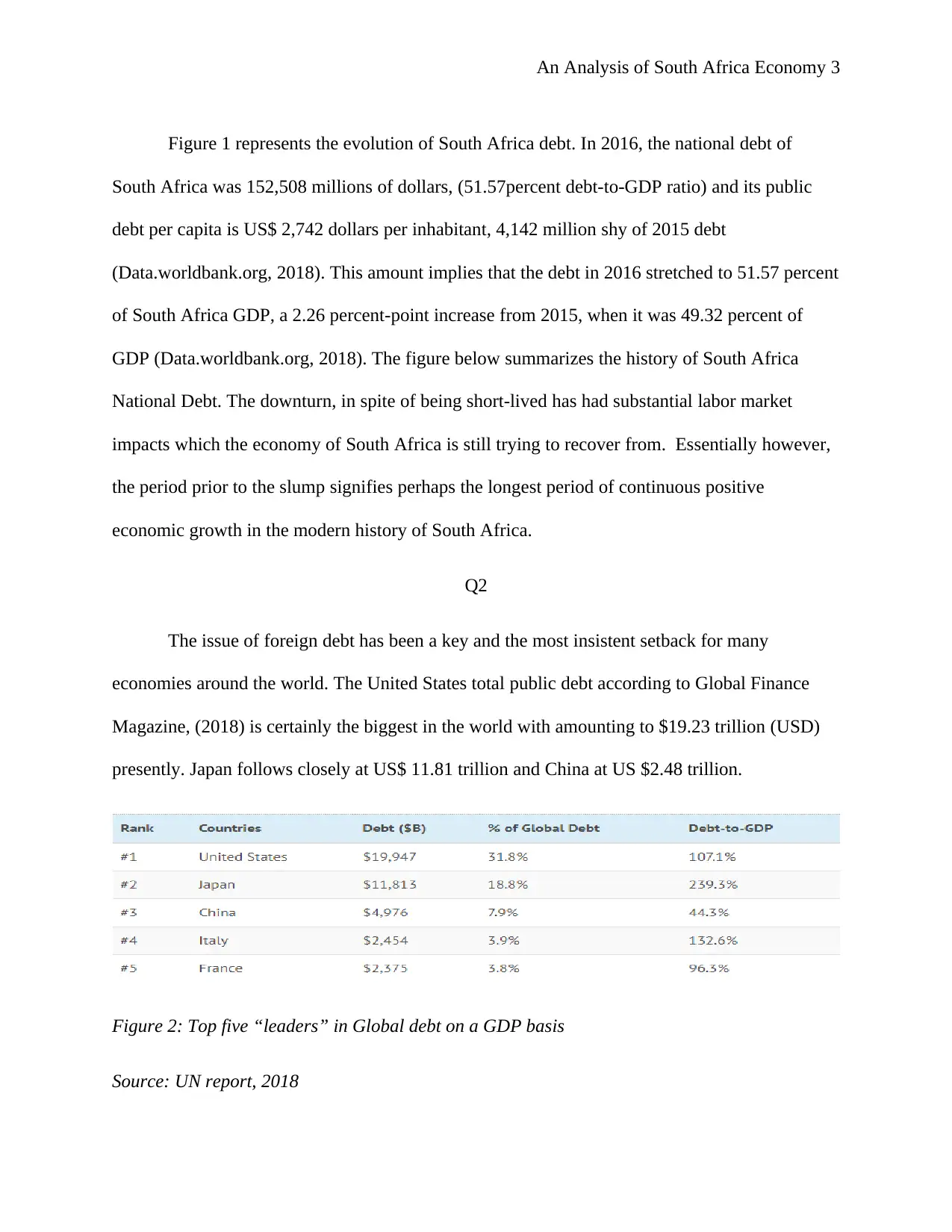
An Analysis of South Africa Economy 3
Figure 1 represents the evolution of South Africa debt. In 2016, the national debt of
South Africa was 152,508 millions of dollars, (51.57percent debt-to-GDP ratio) and its public
debt per capita is US$ 2,742 dollars per inhabitant, 4,142 million shy of 2015 debt
(Data.worldbank.org, 2018). This amount implies that the debt in 2016 stretched to 51.57 percent
of South Africa GDP, a 2.26 percent-point increase from 2015, when it was 49.32 percent of
GDP (Data.worldbank.org, 2018). The figure below summarizes the history of South Africa
National Debt. The downturn, in spite of being short-lived has had substantial labor market
impacts which the economy of South Africa is still trying to recover from. Essentially however,
the period prior to the slump signifies perhaps the longest period of continuous positive
economic growth in the modern history of South Africa.
Q2
The issue of foreign debt has been a key and the most insistent setback for many
economies around the world. The United States total public debt according to Global Finance
Magazine, (2018) is certainly the biggest in the world with amounting to $19.23 trillion (USD)
presently. Japan follows closely at US$ 11.81 trillion and China at US $2.48 trillion.
Figure 2: Top five “leaders” in Global debt on a GDP basis
Source: UN report, 2018
Figure 1 represents the evolution of South Africa debt. In 2016, the national debt of
South Africa was 152,508 millions of dollars, (51.57percent debt-to-GDP ratio) and its public
debt per capita is US$ 2,742 dollars per inhabitant, 4,142 million shy of 2015 debt
(Data.worldbank.org, 2018). This amount implies that the debt in 2016 stretched to 51.57 percent
of South Africa GDP, a 2.26 percent-point increase from 2015, when it was 49.32 percent of
GDP (Data.worldbank.org, 2018). The figure below summarizes the history of South Africa
National Debt. The downturn, in spite of being short-lived has had substantial labor market
impacts which the economy of South Africa is still trying to recover from. Essentially however,
the period prior to the slump signifies perhaps the longest period of continuous positive
economic growth in the modern history of South Africa.
Q2
The issue of foreign debt has been a key and the most insistent setback for many
economies around the world. The United States total public debt according to Global Finance
Magazine, (2018) is certainly the biggest in the world with amounting to $19.23 trillion (USD)
presently. Japan follows closely at US$ 11.81 trillion and China at US $2.48 trillion.
Figure 2: Top five “leaders” in Global debt on a GDP basis
Source: UN report, 2018
⊘ This is a preview!⊘
Do you want full access?
Subscribe today to unlock all pages.

Trusted by 1+ million students worldwide
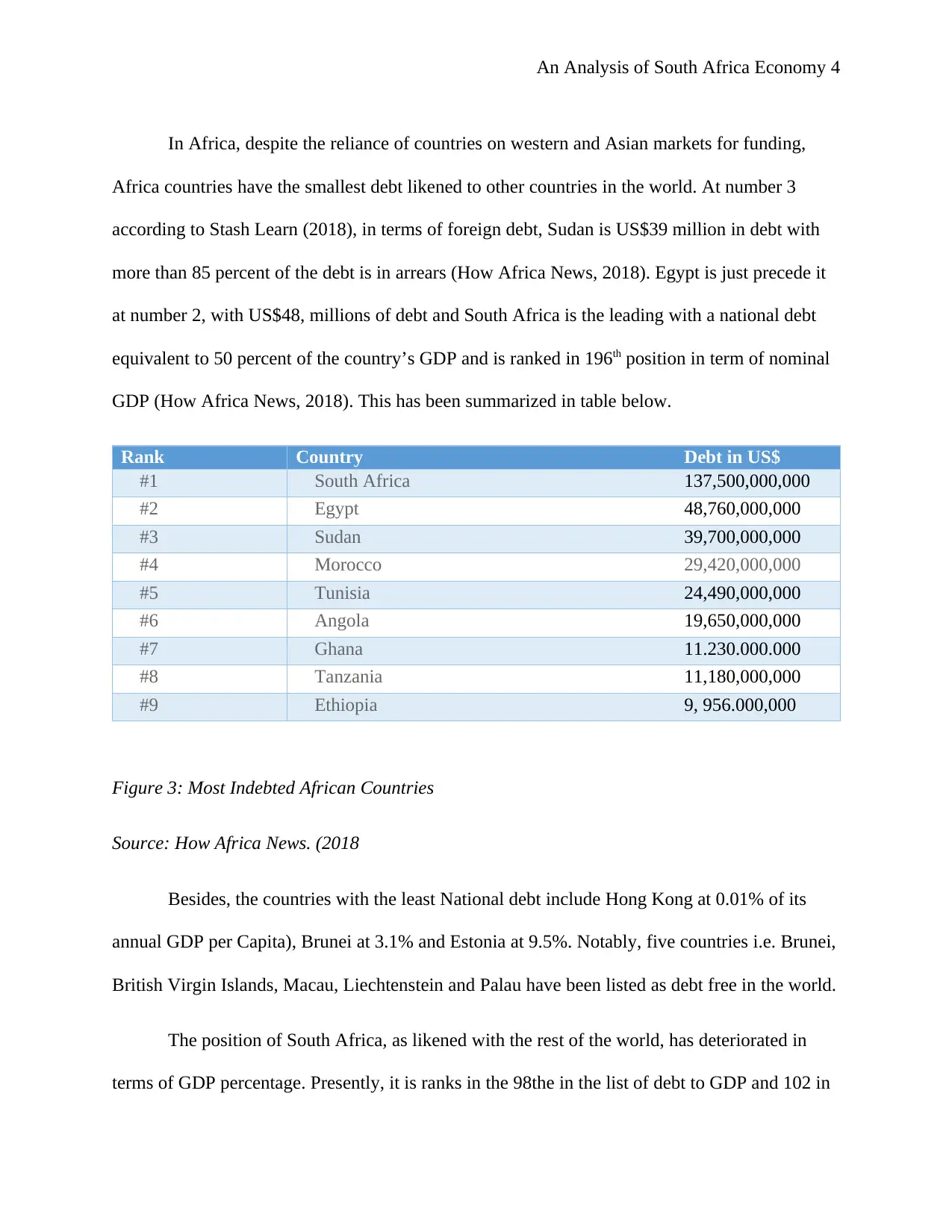
An Analysis of South Africa Economy 4
In Africa, despite the reliance of countries on western and Asian markets for funding,
Africa countries have the smallest debt likened to other countries in the world. At number 3
according to Stash Learn (2018), in terms of foreign debt, Sudan is US$39 million in debt with
more than 85 percent of the debt is in arrears (How Africa News, 2018). Egypt is just precede it
at number 2, with US$48, millions of debt and South Africa is the leading with a national debt
equivalent to 50 percent of the country’s GDP and is ranked in 196th position in term of nominal
GDP (How Africa News, 2018). This has been summarized in table below.
Rank Country Debt in US$
#1 South Africa 137,500,000,000
#2 Egypt 48,760,000,000
#3 Sudan 39,700,000,000
#4 Morocco 29,420,000,000
#5 Tunisia 24,490,000,000
#6 Angola 19,650,000,000
#7 Ghana 11.230.000.000
#8 Tanzania 11,180,000,000
#9 Ethiopia 9, 956.000,000
Figure 3: Most Indebted African Countries
Source: How Africa News. (2018
Besides, the countries with the least National debt include Hong Kong at 0.01% of its
annual GDP per Capita), Brunei at 3.1% and Estonia at 9.5%. Notably, five countries i.e. Brunei,
British Virgin Islands, Macau, Liechtenstein and Palau have been listed as debt free in the world.
The position of South Africa, as likened with the rest of the world, has deteriorated in
terms of GDP percentage. Presently, it is ranks in the 98the in the list of debt to GDP and 102 in
In Africa, despite the reliance of countries on western and Asian markets for funding,
Africa countries have the smallest debt likened to other countries in the world. At number 3
according to Stash Learn (2018), in terms of foreign debt, Sudan is US$39 million in debt with
more than 85 percent of the debt is in arrears (How Africa News, 2018). Egypt is just precede it
at number 2, with US$48, millions of debt and South Africa is the leading with a national debt
equivalent to 50 percent of the country’s GDP and is ranked in 196th position in term of nominal
GDP (How Africa News, 2018). This has been summarized in table below.
Rank Country Debt in US$
#1 South Africa 137,500,000,000
#2 Egypt 48,760,000,000
#3 Sudan 39,700,000,000
#4 Morocco 29,420,000,000
#5 Tunisia 24,490,000,000
#6 Angola 19,650,000,000
#7 Ghana 11.230.000.000
#8 Tanzania 11,180,000,000
#9 Ethiopia 9, 956.000,000
Figure 3: Most Indebted African Countries
Source: How Africa News. (2018
Besides, the countries with the least National debt include Hong Kong at 0.01% of its
annual GDP per Capita), Brunei at 3.1% and Estonia at 9.5%. Notably, five countries i.e. Brunei,
British Virgin Islands, Macau, Liechtenstein and Palau have been listed as debt free in the world.
The position of South Africa, as likened with the rest of the world, has deteriorated in
terms of GDP percentage. Presently, it is ranks in the 98the in the list of debt to GDP and 102 in
Paraphrase This Document
Need a fresh take? Get an instant paraphrase of this document with our AI Paraphraser

An Analysis of South Africa Economy 5
debt per capita, out of the 185 that are usually published by countryeconomy.com. Nonetheless,
Nigeria and Algeria have the least national debt in Africa at 18 and 21 percent respectively of
their GDP per capital
Q3
Formerly gross domestic fixed investment, gross fixed capital formation comprises land
improvements (ditches, drains, fences, etc.); machinery, plant, and equipment acquisitions; and
the construction of railways, roads, and the like, including offices, schools, hospitals, private
residential residences, and industrial and commercial buildings. As stated by
Pubdocs.worldbank.org (2018), net purchase of valuables are also regarded capital formation.
According to the South Africa annualized National Statistics by Countryeconomy.com (2018),
the Gross Fixed Capital Formation in the country approximated 295488.58 ZAR Million from
1960 till 2018, hitting an all-time high of 652624.20 ZAR Million in the third-quarter of 2015
and a record low of 73065 ZAR Million in the second- quarter of 1962. More recently, the Gross
Fixed Capital Formation in South Africa declined from 622124.80 ZAR Million in the fourth
quarter of 2017 to 617115.60 ZAR Million in the first-quarter of 2018. Figure 4 and 5 show
South Africa Gross fixed Capital Formation form 1969-2018
debt per capita, out of the 185 that are usually published by countryeconomy.com. Nonetheless,
Nigeria and Algeria have the least national debt in Africa at 18 and 21 percent respectively of
their GDP per capital
Q3
Formerly gross domestic fixed investment, gross fixed capital formation comprises land
improvements (ditches, drains, fences, etc.); machinery, plant, and equipment acquisitions; and
the construction of railways, roads, and the like, including offices, schools, hospitals, private
residential residences, and industrial and commercial buildings. As stated by
Pubdocs.worldbank.org (2018), net purchase of valuables are also regarded capital formation.
According to the South Africa annualized National Statistics by Countryeconomy.com (2018),
the Gross Fixed Capital Formation in the country approximated 295488.58 ZAR Million from
1960 till 2018, hitting an all-time high of 652624.20 ZAR Million in the third-quarter of 2015
and a record low of 73065 ZAR Million in the second- quarter of 1962. More recently, the Gross
Fixed Capital Formation in South Africa declined from 622124.80 ZAR Million in the fourth
quarter of 2017 to 617115.60 ZAR Million in the first-quarter of 2018. Figure 4 and 5 show
South Africa Gross fixed Capital Formation form 1969-2018
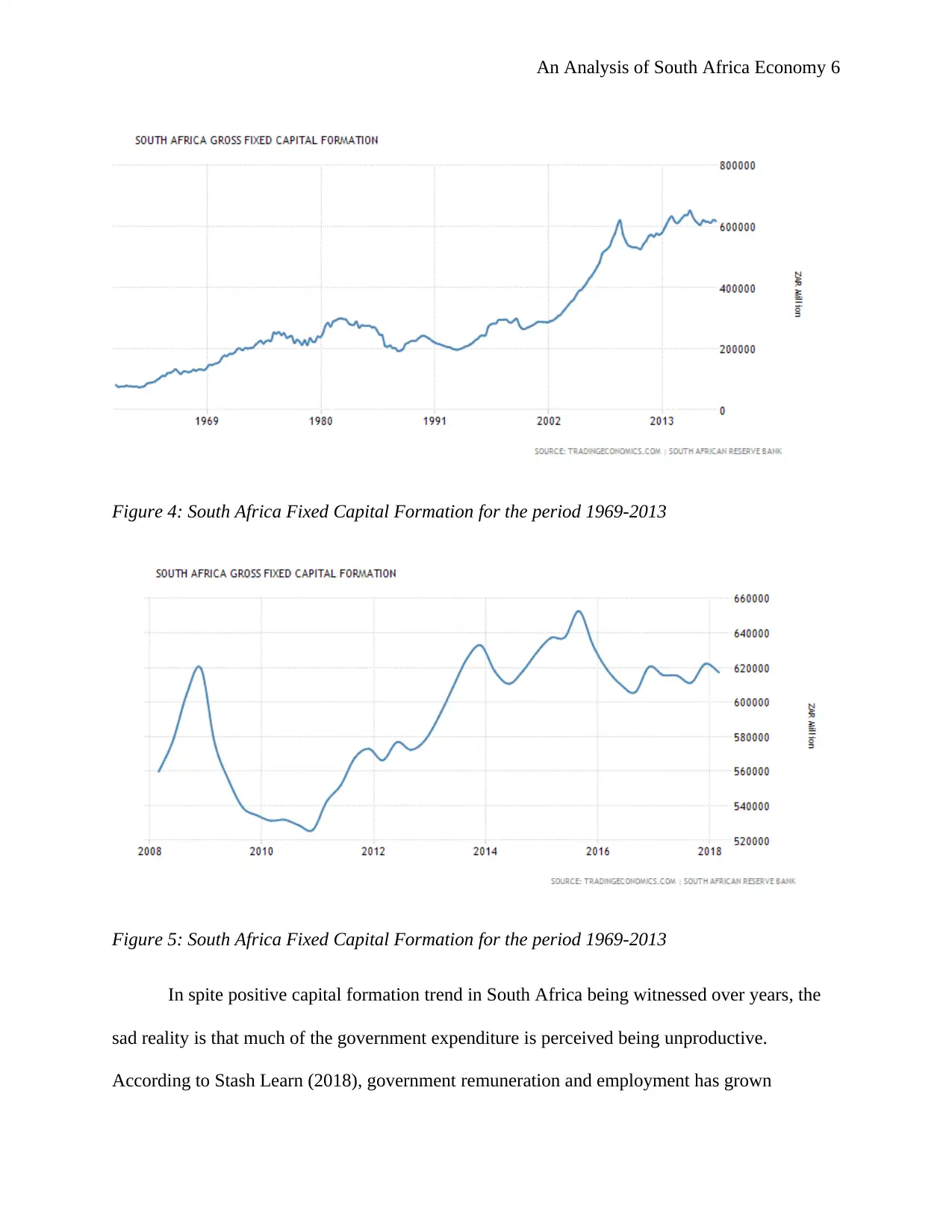
An Analysis of South Africa Economy 6
Figure 4: South Africa Fixed Capital Formation for the period 1969-2013
Figure 5: South Africa Fixed Capital Formation for the period 1969-2013
In spite positive capital formation trend in South Africa being witnessed over years, the
sad reality is that much of the government expenditure is perceived being unproductive.
According to Stash Learn (2018), government remuneration and employment has grown
Figure 4: South Africa Fixed Capital Formation for the period 1969-2013
Figure 5: South Africa Fixed Capital Formation for the period 1969-2013
In spite positive capital formation trend in South Africa being witnessed over years, the
sad reality is that much of the government expenditure is perceived being unproductive.
According to Stash Learn (2018), government remuneration and employment has grown
⊘ This is a preview!⊘
Do you want full access?
Subscribe today to unlock all pages.

Trusted by 1+ million students worldwide
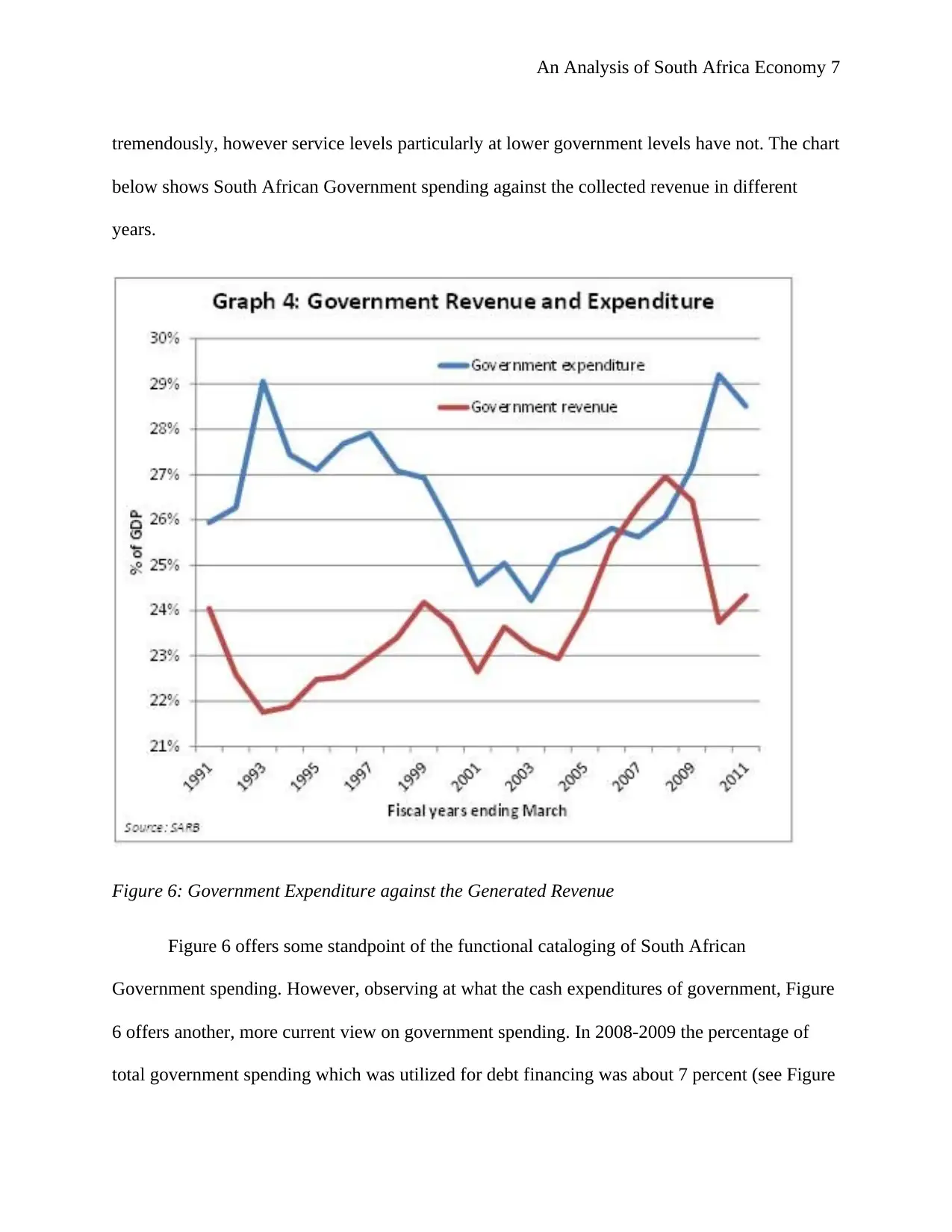
An Analysis of South Africa Economy 7
tremendously, however service levels particularly at lower government levels have not. The chart
below shows South African Government spending against the collected revenue in different
years.
Figure 6: Government Expenditure against the Generated Revenue
Figure 6 offers some standpoint of the functional cataloging of South African
Government spending. However, observing at what the cash expenditures of government, Figure
6 offers another, more current view on government spending. In 2008-2009 the percentage of
total government spending which was utilized for debt financing was about 7 percent (see Figure
tremendously, however service levels particularly at lower government levels have not. The chart
below shows South African Government spending against the collected revenue in different
years.
Figure 6: Government Expenditure against the Generated Revenue
Figure 6 offers some standpoint of the functional cataloging of South African
Government spending. However, observing at what the cash expenditures of government, Figure
6 offers another, more current view on government spending. In 2008-2009 the percentage of
total government spending which was utilized for debt financing was about 7 percent (see Figure
Paraphrase This Document
Need a fresh take? Get an instant paraphrase of this document with our AI Paraphraser

An Analysis of South Africa Economy 8
4). Meanwhile, this crept up to 8.6% percent in the period 2011-2012, and to 9.6 percent in 2013.
Over the last four years, the total expenditure in relation to GDP has rocketed by over 15.5% p.a.
Q4
Having high national public debt can fast turn into an economic crisis for a country. If
financial markets, the country's capability to repay its debt is too uncertain or is not sufficient, it
will find additional borrowings to be exceedingly expensive or impossible (Global Finance
Magazine, 2018) ponder that. Ultimately, the economy may find itself repressed by a lack of
credit. It does seem like South Africa contemplates about finding itself in a debt trap which is a
very difficult position to get out of. Naturally, when the going gets certainly tough, more debt is
amassed just to pay back other debts, and this boundless cycle of paying off debt rather than
using the money on the inhabitants of the nation hampers economic development and progress.
C (2018) compares debt to a ships anger being positioned while the ship essentially wants to sail.
It withholds the ship, and in the same way excessive debt for a particular state suppresses it from
advancing and developing. Accordingly, South Africa’s debt can be abated through transparency
of government, investing local currency debt markets and tax collection. These are opportunities
that South Africa should not ignore.
4). Meanwhile, this crept up to 8.6% percent in the period 2011-2012, and to 9.6 percent in 2013.
Over the last four years, the total expenditure in relation to GDP has rocketed by over 15.5% p.a.
Q4
Having high national public debt can fast turn into an economic crisis for a country. If
financial markets, the country's capability to repay its debt is too uncertain or is not sufficient, it
will find additional borrowings to be exceedingly expensive or impossible (Global Finance
Magazine, 2018) ponder that. Ultimately, the economy may find itself repressed by a lack of
credit. It does seem like South Africa contemplates about finding itself in a debt trap which is a
very difficult position to get out of. Naturally, when the going gets certainly tough, more debt is
amassed just to pay back other debts, and this boundless cycle of paying off debt rather than
using the money on the inhabitants of the nation hampers economic development and progress.
C (2018) compares debt to a ships anger being positioned while the ship essentially wants to sail.
It withholds the ship, and in the same way excessive debt for a particular state suppresses it from
advancing and developing. Accordingly, South Africa’s debt can be abated through transparency
of government, investing local currency debt markets and tax collection. These are opportunities
that South Africa should not ignore.

An Analysis of South Africa Economy 9
References List
C, L. (2018). South Africa's growing public debt. [online] Financialmarketsjournal.co.za.
Available at: http://financialmarketsjournal.co.za/oldsite/15thedition/printed%20articles/
publicdebt.htm [Accessed 8 Aug. 2018].
countryeconomy.com. (2018). General government gross debt 2017. [online] Available at:
https://countryeconomy.com/national-debt [Accessed 7 Aug. 2018].
countryeconomy.com. (2018). South Africa National Debt 2016. [online] Available at:
https://countryeconomy.com/national-debt/south-africa [Accessed 7 Aug. 2018].
Data.worldbank.org. (2018). South Africa | Data. [online] Available at:
https://data.worldbank.org/country/south-africa [Accessed 7 Aug. 2018
Global Finance Magazine. (2018). Global Finance Magazine - Countries With The Most
External Debt in 2017. [online] Available at: https://www.gfmag.com/global-data/economic-
data/xtegh9-external-debt-in-countries-around-the-world [Accessed 8 Aug. 2018].
Heritage.org. (2018). South Africa Economy: Population, GDP, Inflation, Business, Trade, FDI,
Corruption. [online] Available at: https://www.heritage.org/index/country/southafrica [Accessed
7 Aug. 2018].
How Africa News. (2018). Africa’s Top 10 Most Indebted Countries According to World Bank
Revealed – Is your country among?. [online] Available at: https://howafrica.com/africas-top-10-
most-indebted-countries-according-to-world-bank-revealed-is-your-country-among/ [Accessed 8
Aug. 2018].
References List
C, L. (2018). South Africa's growing public debt. [online] Financialmarketsjournal.co.za.
Available at: http://financialmarketsjournal.co.za/oldsite/15thedition/printed%20articles/
publicdebt.htm [Accessed 8 Aug. 2018].
countryeconomy.com. (2018). General government gross debt 2017. [online] Available at:
https://countryeconomy.com/national-debt [Accessed 7 Aug. 2018].
countryeconomy.com. (2018). South Africa National Debt 2016. [online] Available at:
https://countryeconomy.com/national-debt/south-africa [Accessed 7 Aug. 2018].
Data.worldbank.org. (2018). South Africa | Data. [online] Available at:
https://data.worldbank.org/country/south-africa [Accessed 7 Aug. 2018
Global Finance Magazine. (2018). Global Finance Magazine - Countries With The Most
External Debt in 2017. [online] Available at: https://www.gfmag.com/global-data/economic-
data/xtegh9-external-debt-in-countries-around-the-world [Accessed 8 Aug. 2018].
Heritage.org. (2018). South Africa Economy: Population, GDP, Inflation, Business, Trade, FDI,
Corruption. [online] Available at: https://www.heritage.org/index/country/southafrica [Accessed
7 Aug. 2018].
How Africa News. (2018). Africa’s Top 10 Most Indebted Countries According to World Bank
Revealed – Is your country among?. [online] Available at: https://howafrica.com/africas-top-10-
most-indebted-countries-according-to-world-bank-revealed-is-your-country-among/ [Accessed 8
Aug. 2018].
⊘ This is a preview!⊘
Do you want full access?
Subscribe today to unlock all pages.

Trusted by 1+ million students worldwide
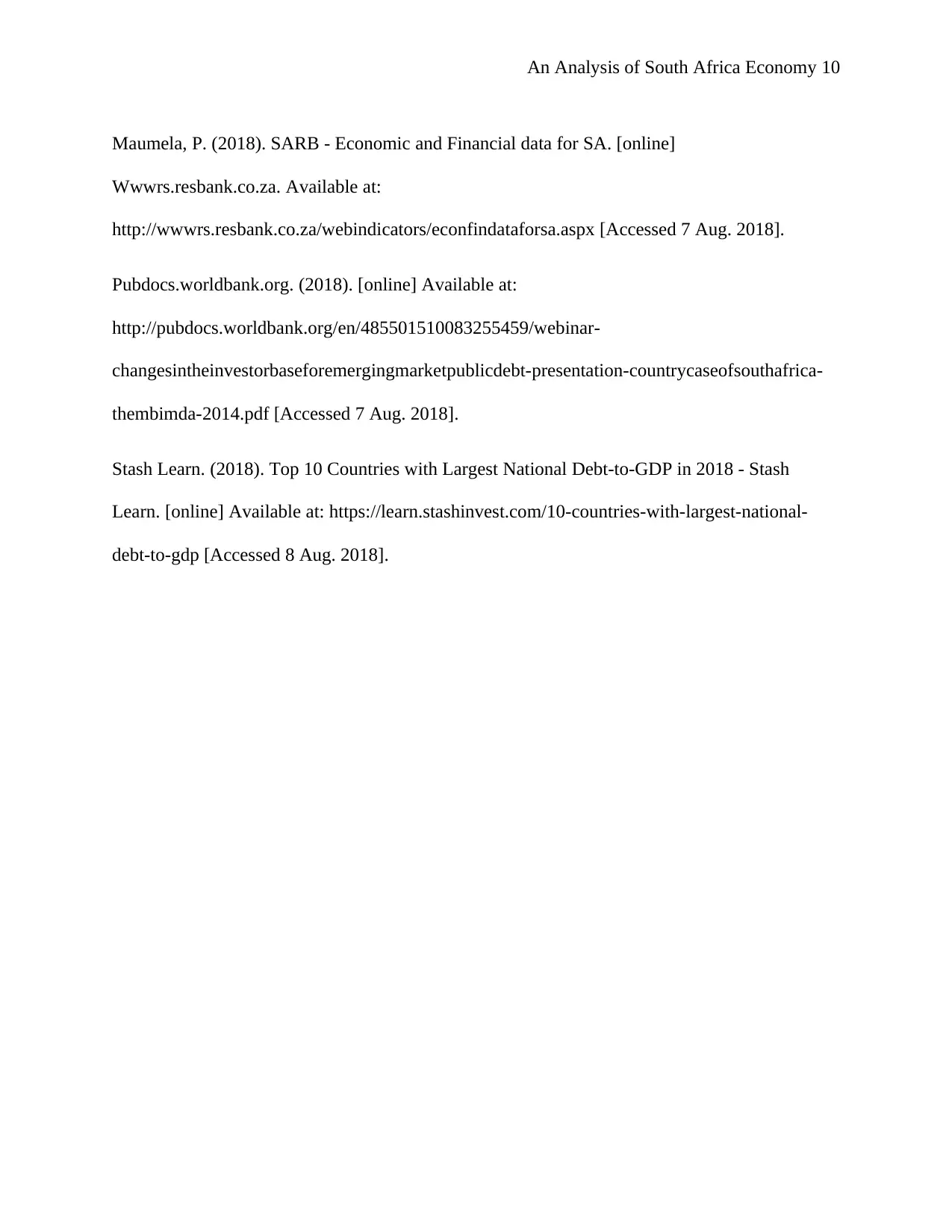
An Analysis of South Africa Economy 10
Maumela, P. (2018). SARB - Economic and Financial data for SA. [online]
Wwwrs.resbank.co.za. Available at:
http://wwwrs.resbank.co.za/webindicators/econfindataforsa.aspx [Accessed 7 Aug. 2018].
Pubdocs.worldbank.org. (2018). [online] Available at:
http://pubdocs.worldbank.org/en/485501510083255459/webinar-
changesintheinvestorbaseforemergingmarketpublicdebt-presentation-countrycaseofsouthafrica-
thembimda-2014.pdf [Accessed 7 Aug. 2018].
Stash Learn. (2018). Top 10 Countries with Largest National Debt-to-GDP in 2018 - Stash
Learn. [online] Available at: https://learn.stashinvest.com/10-countries-with-largest-national-
debt-to-gdp [Accessed 8 Aug. 2018].
Maumela, P. (2018). SARB - Economic and Financial data for SA. [online]
Wwwrs.resbank.co.za. Available at:
http://wwwrs.resbank.co.za/webindicators/econfindataforsa.aspx [Accessed 7 Aug. 2018].
Pubdocs.worldbank.org. (2018). [online] Available at:
http://pubdocs.worldbank.org/en/485501510083255459/webinar-
changesintheinvestorbaseforemergingmarketpublicdebt-presentation-countrycaseofsouthafrica-
thembimda-2014.pdf [Accessed 7 Aug. 2018].
Stash Learn. (2018). Top 10 Countries with Largest National Debt-to-GDP in 2018 - Stash
Learn. [online] Available at: https://learn.stashinvest.com/10-countries-with-largest-national-
debt-to-gdp [Accessed 8 Aug. 2018].
1 out of 10
Related Documents
Your All-in-One AI-Powered Toolkit for Academic Success.
+13062052269
info@desklib.com
Available 24*7 on WhatsApp / Email
![[object Object]](/_next/static/media/star-bottom.7253800d.svg)
Unlock your academic potential
Copyright © 2020–2026 A2Z Services. All Rights Reserved. Developed and managed by ZUCOL.





